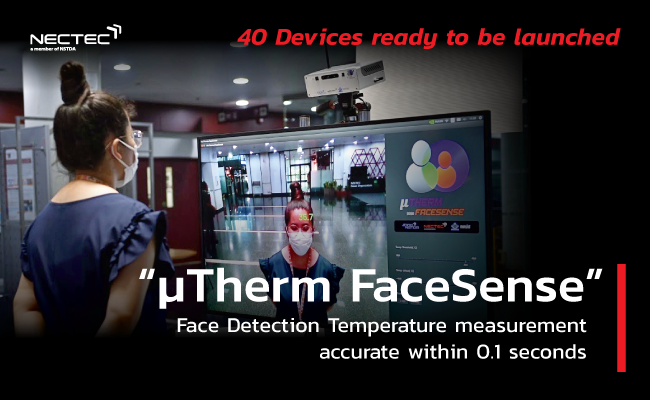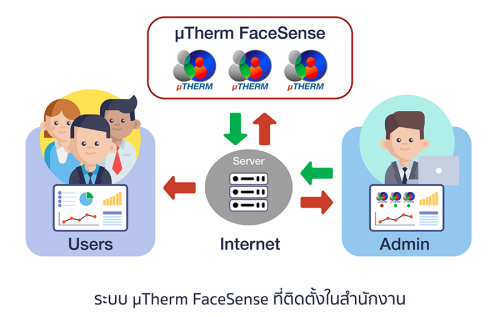
- Author | Walailak Kongprajan
English Translator | Siri-on Umarin, Rungroj Jintamethasawat, Ph.D
Photographer | Kornrawee Kaewmoon, Sasiwipar Hasuk
With the emerging of COVID-19 outbreak, Thai people take notice of their body temperature as it is one of the measurable factors for the COVID-19 and other virus infections i.e. Influenza, Acute Respiratory Disease, Encephalitis, Malaria, and Dengue Fever, etc.
Measuring body temperature before entering any building, especially in the most crowded areas, has become the first precautionary procedure. Infrared thermometers are cost-effective devices that are widely used, but its drawback is an inability to detect several people simultaneously and perform wide-range scanning. Thermal imaging cameras are also employed in the airport or department stores. Though they have better detection throughput, they are more expensive. This has prompted Thai researchers to develop a new affordable temperature measurement system. Unlike other commercial systems, this system can identify temperatures of multiple persons at the same time and can store important data from suspects. The idea behind this useful feature is utilizing additional information from a typical, off-the-shelf camera that provides color images, and applying an accurate face detection algorithm on there. This system can identify temperatures of up to 9 persons within only 0.1 seconds (within 1.5-meter range). Additionally, it supports IoT computing and data storage.
μTherm FaceSense: A Smart Temperature Measurement System
“μTherm FaceSense” is a multi-people temperature screening system utilizing IoT computing and data storage. Its portability and integration to IoT computing technology are major improvements over its old version. It is now supported by the Office of the National Broadcasting and Telecommunication Commission (OBTC).

Dr.Saran Samritdetkajorn, Acting Deputy Executive Director of NECTEC said, “μTherm FaceSense” is based on the former IP of the researcher including the non-invasive automatic temperature measurement system. This system further links collected data to an IoT computing system, and enables accurate temperature measurements of several persons simultaneously.


μTherm FaceSense has a maximum screening range of 1.5 meters and has a screening time only within 0.1 seconds. The measured temperature will be overlaid over a person’s face on the screen. If the temperature exceeds the pre-specified threshold, its color will change from green to red with a warning sound. Furthermore, μTherm FaceSense provides flexibility to configure relevant parameters such as offset temperature, variations of measurement range (already patented by PHT, NECTEC). These allow undesirable effects, such as ambient temperature, humidity, and range, to be minimized as much as possible.

Dr. Chalee Vorakulpiphat, a head researcher of the Information Security Research Team (SEC), explained that the face detection algorithm his team developed is able to accurately identify multiple persons in the same scene. This ensures that the system collects temperature measurements at regions of interest that actually correspond to human faces. Such non-contact procedure helps reduce the risk of exposure from staff to screening recipients, and vice versa.
“In the past, our team developed full-face detection, but since COVID-19 pandemic has spreaded out, people need to wear a mask. Therefore, we develop a new technique that can identify faces even covered by masks. Meanwhile, this technique could be further developed in the contexts of security and safety in the future.” said Dr. Charlie.

Mr. Armote Somboonkaew, a researcher from the Photonics Technology Research Team (PHT) and who is a project leader of µTherm-FaceSense system, said that µTherm-FaceSense system is easy to install. Once the system is connected to the external display via an HDMI cable, it is up and running. In addition, NECTEC researchers have designed a software to analyze and store the data within the internal system. Moreover, the software can access and transfer the analyzed data through the internet, via a 3G/4G or a Wi-Fi connection.
- In the near future, the research team plans to store temperature measurements and captured face images in an organizational server, so that authorized personnel can verify those information via Dashboard, Web Server, or other Application if needed. This helps in controlling the number of infected people and tracking the pandemic status in real-time especially in crowded places that pose a high risk of contagion, such as hospitals, department stores, office buildings, and factories.
µTherm-FaceSense Timeline
